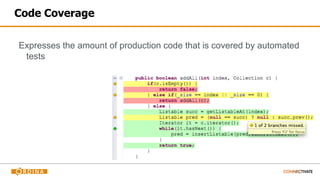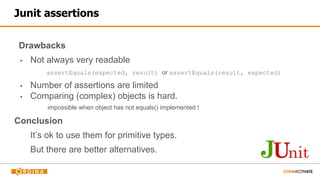Ad
Unit testing - A&BP CC
- 1. Unit Testing the right way Expressive, useful, and maintainable testing
- 2. The Red Line Goal of Testing What to Test Fixtures Mocks Assertions
- 3. The Red Line Goal of Testing What to Test Fixtures Mocks Assertions
- 5. 100% Code Coverage Test coverage is a useful tool for finding untested parts of a codebase. Test coverage is of little use as a numeric statement of how good your tests are. -- Martin Fowler
- 6. public static String foo(boolean someCondition){ String bar = null; if (someCondition) { bar = "blabla"; } return bar.trim(); } 100% Code Coverage assertEquals("blabla", foo(true)); assertEquals("blabla", foo(false)); Line Coverage 100% Bug Coverage 0%
- 7. Reduce Costs Most of our time is spent on debugging and fixing bugs. Bugs - if not fixed soon in the development process - cost a lot more than the development itself Google est. bug cost when fixed at: Development time $5 Automated build time $50 Integration testing time $500 System testing time $5000
- 8. Tests as documentation Tests have to be… 1. comprehensive 2. run often and work 3. written to be read
- 9. Tests as documentation Method names are important to keep tests readable While a very subjective topic, a good practice can be: dividesAmountByFactor throws_Illegal_Argument_Exception_When_Dividing_By_Zero throws_exception_when_dividing_by_zero private double amount; public double divide(double factor){ if (factor == 0) throw new IllegalArgumentException(); return amount/factor; }
- 10. Tests as documentation ● Arrange ● Act ● Assert ● Given ● When ● Then
- 11. Tests as safety net for refactoring
- 12. Tests make you think about your implementation ▪ Tests often trigger refactors and even redesigns ▪ Tests make us really think about the requirements ▪ Tests make us find gaps in the requirements
- 13. Conclusion Write unit tests to… … reduce costs / save time … be able to confidently refactor … look at your technical design from a different angle … look at your requirements from a different angle
- 14. The Red Line Goal of Testing What to Test Fixtures Mocks Assertions
- 15. WHAT TO TEST
- 16. Test isolated units Keep level of collaboration the smallest possible in units under test
- 17. Test isolated units Smallest possible
- 18. Test isolated units Test in complete isolation
- 19. Test isolated units No knowledge of implementation details of called method of collaborator
- 20. Test isolated units How ? Extensive use of mocked-out collaborators in non-leaf objects/classes
- 21. Test isolated units It results mostly in one test-class per class e.g: MyClass and MyClassTest
- 22. Test isolated units Advantage: Less tests to write Smaller tests to write Less complicated setup of fixtures Probably all branches covered quickly
- 23. Boundary Cases Test cases that cover the full spectrum of possible values. Example 1: A method that accepts only int values between 0 and 100 public void compute(int value){} Test with -1, 0, 10, 50, 100, 101, 'A'
- 24. Boundary Cases Example 2: A method that removes a character in a String text public String remove(String text, char ch) 1. Test for null text 2. Test for empty text 3. Test for character which is not in String 4. Test for characters which comes during start, end or middle of String 5. Test to cover if text String contains just one character which is equal or not equal to the to be removed one 6. Test with String contains just one character multiple times
- 25. Branches Every time that a different path of execution can be triggered results in a different branch Basically: if, else, for, while, do blocks and even collaborators if(condition){ } 2 branches : if true and if false
- 26. Branches: Cyclomatic complexity Mathematical result of a formula to calculate the complexity of a piece of code.
- 27. Branches: Cyclomatic complexity Start with a count of one for the method. Add one for each of the following flow-related elements that are found in the method. Methods Each return that isn't the last statement of a method Selection if, else, case, default Loops for, while, do-while, break, and continue Operators &&, ||, ?, and : Exceptions catch, finally, throw, or throws clause Threads start() call on a thread. Of course, this is a ridiculous underestimate!
- 28. Branches: Cyclomatic complexity If this number is higher than 10 it becomes nearly impossible to test. “Impossible to test” = impossible to have full branch coverage
- 29. Branches: Cyclomatic complexity Keep this number low !! How ? CLEAN CODE!!!!
- 30. Branches: Cyclomatic complexity Where? SonarQube calculates this out of the box
- 31. Code Coverage Expresses the amount of production code that is covered by automated tests
- 32. Code Coverage
- 33. Code Coverage: Tools JaCoCo: replacement for Emma, fully supports Java 7 and 8, used by Sonar, EclEmma(used to be based on EMMA), Jenkins, Netbeans, IntelliJ IDEA, Gradle Clover: Atlassian → commercial Cobertura
- 34. Conclusion What to test : ▪ Completely in isolation ▪ All Boundary cases ▪ All branches Be aware of : ▪ Cyclomatic complexity ▪ SonarQube calculates it out of the box for you ▪ Branch coverage ▪ Calculation possible by ▪ Jacoco, Emma, Clover, Cobertura
- 35. The Red Line Goal of Testing What to Test Fixtures Mocks Assertions
- 36. FIXTURES
- 37. Definition (non-software) A Fixture in non-software development is e.g.: the setup of a controlled environment to test the functioning of a piece of hardware
- 38. Definition (software) A fixed state of software under test used as baseline for running tests = test context Preparation of input data and setup/creation of fake or mock objects
- 39. Definition (software) Main benefit: It avoids duplication of code necessary to initialize and clean up common objects
- 40. Use in JUnit From Junit 4 on there are Java 5 annotations for setting up Test fixture: @Before, @BeforeClass, @After, @AfterClass
- 41. @Before, @BeforeClass, @After, @AfterClass @BeforeClass public static void prepareSomeResources() @Before public void setUpFixtureForAllTests() @After public void freeResourcesAfterEachTest() @AfterClass public static void freeResourcesAfterAllTestsRan()
- 42. ObjectMother
- 43. ObjectMother Factory for creating fixtures that are used in several test classes. Catchy name thought of at thoughtworks http://martinfowler.com/bliki/ObjectMother.html
- 44. ObjectMother private PsychoKiller hanibal; @Before public void setupFixtureForHanibalLastKill2DaysAgo(){ hanibal = new PsychoKiller(); hanibal.setFirstName(“Hanibal”); hanibal.setLastName(“Lecter”); hanibal.setLastKillDate(current - 2 days); }
- 45. ObjectMother private PsychoKiller hanibal; @Before public void setupFixtureForHanibalLastKill2DaysAgo(){ hanibal = PsychoKillerMother. getHanibalLastKill2DaysAgo(); } @Test public void returns_true_if_less_than_4_days(){ assertTrue(hanibal.killedRecently()); }
- 46. Conclusion ▪ Use Fixtures to reduce code duplication ▪ In JUnit 4 : @Before @BeforeClass @After @AfterClass ▪ ObjectMother: to help keeping setup of fixtures small and concise and in one place so reusable for other test-classes
- 47. The Red Line Goal of Testing What to Test Fixtures Mocks Assertions
- 48. MOCKS
- 49. Why? Mocking, Spies, Stubs, Doubles & fancy buzzwords
- 50. Isolate the code under test Test one object, not the collaborators !
- 51. Speed up test execution Canned replies are fast !
- 52. Make execution deterministic Less variables means more control !
- 53. Simulate special condition Don’t stick to the happy path.
- 54. Gain access to hidden information Can you see The Hidden Tiger?
- 55. Our example codebase Fancy cars !
- 56. Codebase: Car public class Car { public void setEngine(final Engine engine) {...} public void start() {...} public void stop() { … } }
- 57. Codebase: Engine public interface Engine { void start(); void stop(); boolean isRunning(); } public class DieselEngine implements Engine;
- 60. Dummy Dummy objects are passed around but never actually used. Usually they are just used to fill parameter lists
- 61. POJO Dummy public class TestMockDummy { final Engine dummyEngine = new DieselEngine(); Car testedCar = new Car(new DieselEngine()); @Test(expected = IllegalStateException.class) public void testExceptionIfCarStarted() { testedCar.start(); testedCar.setEngine(dummyEngine); } }
- 62. Fake Fake objects have working implementations, but usually take some shortcut which makes them not suitable for production
- 63. POJO Fake private final Engine fakeEngine = new Engine() { boolean started=false; @Override public void stop() { started=false; } @Override public void start() { started=true; } @Override public boolean isRunning() { return started; } };
- 64. POJO Fake (cont) … private final Car carWithStartableEngine = new Car(fakeEngine); @Test public void testCarCanStart() { carWithStartableEngine.start(); Assert.assertTrue(carWithStartableEngine.isStarted); } …
- 65. Stubs Stubs provide canned answers to calls made during the test, usually not responding at all to anything outside what's programmed for the test.
- 66. POJO Stubs private final Engine stubEngine = new Engine() { @Override public void stop() {} @Override public void start() {} @Override public boolean isRunning() { return false; } };
- 67. POJO Subs (cont) private final Car car = new Car(stubEngine); @Test public void testCarDoesNotStartWithoutEngine() { car.start(); Assert.assertFalse(car.isStarted); }
- 69. POJO Spies private class SpyEngine extends DieselEngine { int startedCalledCount = 0; @Override public void start() { startedCalledCount++; super.start(); } };
- 70. POJO Spies (cont) private final SpyEngine spyEngine = new SpyEngine(); private final Car spiedTestCar = new Car(spyEngine); @Test public void testCarStartStartsTheEngine() { spiedTestCar.start(); Assert.assertEquals("Engine start is called once", 1, spyEngine.startedCalledCount); }
- 71. Mocks Objects pre-programmed with expectations which form a specification of the calls they are expected to receive.
- 72. EasyMock: Mock (too lazy) @RunWith(EasyMockRunner.class) public class TestMockEasyMock extends EasyMockSupport{ @Mock Engine mockEngine; …
- 73. EasyMock: Mock (cont) @Test public void testCarWithAMockedEngine() { // Set the behavior expect(mockEngine.isRunning()).andReturn(false); mockEngine.start(); expect(mockEngine.isRunning()).andReturn(true); mockEngine.stop(); replayAll();
- 74. EasyMock: Mock (cont 2) // Set a car with our mocked engine Car testedCar = new Car(mockEngine); // Run ! testedCar.start(); testedCar.stop(); // Verify ! verifyAll(); }
- 75. POJO feels a bit ghetto ?
- 76. (Some) Existing frameworks ▪ EasyMock ▪ Mockito ▪ Unitils ▪ JMockit And Much Much more ! Proxy Based Class remap Strict by default Non-Strict by default
- 77. EasyMock 1. Arrange: Create the mock and setup behavior mock = createMock(Collaborator.class); mock.documentChanged("Document"); expectLastCall().times(3); expect(mock.vote("Document")).andReturn((byte)-42); replay(mock); 3. ACT ! classUnderTest.addDocument("Document", "content"); 4. Assert verify(mock);
- 78. Mockito - Behavior Check 1. Arrange List mockedList = mock(List.class); 2. Act mockedList.add("one"); mockedList.clear(); 3. Assert verify(mockedList).add("one"); verify(mockedList).clear();
- 79. Mockito - Stubbing 1. Arrange LinkedList mockedList = mock(LinkedList.class); when(mockedList.get(0)).thenReturn("first"); when(mockedList.get(1)) .thenThrow(new RuntimeException()); 2. Act (examples) System.out.println(mockedList.get(0)); System.out.println(mockedList.get(1)); System.out.println(mockedList.get(999));
- 80. Unitils (mocking) 1. Arrange (Create the mock and setup behavior) myServiceMock = new MockObject<MyService>(MyService.class, this); myServiceMock.returns("a value").someMethod(); 2. Act myServiceMock.getMock().someMethod(); 3. Assert ! myServiceMock.assertNotInvoked().someMethod();
- 81. JMockit - Expectations @Test public void aTestMethod(@Mocked final MyCollaborator mock){ new NonStrictExpectations() {{ mock.getData(); result = "my test data"; mock.doSomething(anyInt, "some expected value", anyString); times=1; }}; // In the replay phase, the tested method would call the "getData" and "doSomething" // methods on a "MyCollaborator" instance. ... // In the verify phase, we may optionally verify expected invocations to // "MyCollaborator" objects. ... }
- 82. JMockit - Verification ... new Verifications() {{ // If no new instance of the mocked class should have been // created with the no-args constructor, we can verify it: new MyCollaborator(); times = 0; // Here we verify that doSomething() was executed at least once: mock.doSomething(); // Another verification, which must have occurred no more than three // times: mock.someOtherMethod( anyBoolean, any, withInstanceOf(Xyz.class)); maxTimes = 3; }}; }
- 83. Conclusion ▪ Mocking helps you to create better tests ▪ Mocking Framework(s) help keeping overhead low
- 84. The Red Line Goal of Testing What to Test Fixtures Mocks Assertions
- 85. ASSERTIONS
- 86. Assertions What ? Verify if the result of the test is what we expected.
- 87. Assertions How ? Should be automated, no human intervention necessary No logging, System.out.println() etc. to be used Use framework(s) to achieve this.
- 88. Junit assertions Types assertEquals, assertSame, assertTrue, assertFalse, assertNull, assertNotNull Advantages Most often used, so best known.
- 89. Junit assertions Drawbacks ▪ Not always very readable assertEquals(expected, result) or assertEquals(result, expected) ▪ Number of assertions are limited ▪ Comparing (complex) objects is hard. impossible when object has not equals() implemented ! Conclusion It’s ok to use them for primitive types. But there are better alternatives.
- 90. Hamcrest assertions What ? ▪ Hamcrest is a framework for writing matcher objects allowing ‘match’ rules to be defined declaratively. assertThat(Object, Matcher<T>); ▪ Can easily be integrated with other frameworks like Junit, TestNG, Mockito, EasyMock, Jmock,...
- 91. Hamcrest assertions Advantages ▪ Improved readability of tests assertThat(ObjectToBeChecked, equalTo(OtherObject)) assertThat(ObjectToBeChecked, is(equalTo(OtherObject)); assertThat(collection, hasSize(2); ▪ Better failure message assertThat(3, greaterThan(5)); Expected: a value greater than <5> but: <3> was less than <5>
- 92. Hamcrest assertions ▪ Combination of Matchers Allows to assert more precisely. assertThat(array, not(emptyArray()); assertThat(collections, everyItem(greaterThan(10)); ▪ Write your own Matcher This can occur when you find a fragment of code that test the same set of properties over and over again and you want to bundle the fragment into a single assertion. But be aware, there are already plenty of matchers available, make sure you are not writing existing code again.
- 93. Hamcrest assertions Example : To test if a double has a value NaN (not a number) Test we want to write : public void testSquareRootOfMinusOneIsNotANumber () { assertThat(Math.sqrt(-1), is(notANumber())); }
- 94. public class IsNotANumber extends TypeSafeMatcher<Double> { @Override public boolean matchesSafely(Double number) { return number.isNaN(); } public void describeTo(Description description) { description.appendText("not a number"); } @Factory public static <T> Matcher<Double> notANumber() { return new IsNotANumber(); } } Hamcrest assertions
- 95. Hamcrest assertions ▪ More possibilities to compare objects It is possible to check objects that don’t have equals() implemented. assertThat(ObjectToBeChecked, samePropertyValuesAs(OtherObject)); but not possible for objects with composition ! Better use ReflectionAssert.assertReflectionEquals of unitils !
- 96. Hamcrest assertions Drawbacks ▪ Finding the right Matcher The matchers are not set in one place. Most matchers are accessible via the Matcher class, but some are located in the CoreMatcher class, and some are in another package. example: hasItem() : Matcher class hasItems() : IsCollectionContaining class
- 97. Other frameworks Unitils ▪ ReflectionAssert This assertion loops over all fields in both objects and compares their values using reflection. If a field value itself is also an object, it will recursively be compared field by field using reflection. The same is true for collections, maps and arrays. ▪ Lenient assertions Adding some levels of leniency to the ReflectionAssert checks. (order list, ignoring defaults, dates, assertLenientEquals) ▪ Property assertions Methods to compare a specific property of two objects assertPropertyLenientEquals("id", 1, user); assertPropertyLenientEquals("address.street", "First street", user);
- 98. Other frameworks Fest (http://code.google.com/p/fest/) Supports both Junit and TestNG assertThat(collection).hasSize(6).contains(frodo, sam);
- 99. Assertions Misuse of assertions ▪ Manual assertions This practice misses out the main benefits of testing automation — the ability to continuously run the tests in the background without intervention ■ Multiple assertions ■ Redundant assertions Extra calls to an assert method where the condition being tested is a hard coded value assertTrue(“always true”, true) ■ Using the wrong assertions assertTrue("Object must be null", actual == null); assertTrue("Object must not be null", actual != null);
- 100. Assertions What about void methods ? Often if a method doesn't return a value, it will have some side effect. There may be a way to verify that the side effect actually occurred as expected. Especially exception testing should not be forgotten.
- 101. Assertions MyClass { public void addElement(String element, List<String> elements) { elements.add(element); } } public void testAddElement() { List<String> elements = new ArrayList(); assertEquals(0, elements.size() ); myClassTest.addElement(“test”, elements); assertEquals(1, elements.size() ); }
- 102. Conclusion ▪ Always make sure your assertions are fully automated ▪ Junit assertions are ok for primitive types ▪ Hamcrest offers a lot of interesting matchers that allows you to assert more precise ▪ Unitils is a better alternative when comparing objects ▪ You can use them all together !
- 103. The Red Line Goal of Testing What to Test Fixtures Mocks Assertions
- 104. Question ?
- 105. PRACTICAL
- 106. Exercises ! github: https://github.com/pijalu/utdemo ▪ Master: Default start ▪ Branches: Different solutions with different mocking framework… Don’t look ;-)
- 107. Factoid - Model Fact ▪ Simple POJO ▪ Stores a fact ▪ It’s a string
- 108. Factoid - Provider Provider interface: ▪ Provides a list of fact to a client ▪ int size(): Number of facts in the provider ▪ Fact getFact(index): Return a fact (0->size-1) ▪ Implementation: ▪ FileFactProvider ▪ Loads facts from a file. ▪ Line oriented
- 109. Factoid- Service FactService interface: ▪ Returns a fact to client: ▪ Fact getAFact(): Return a fact ▪ Implementation: ▪ RandomFactService: ▪ Returns a random fact using a provider ▪ Uses Random ▪ Builds an array to avoid repetition/ensure all facts are returned
- 110. Factoid - Main Factoid main class ▪ Loads a File with a (File)FactProvider ▪ Loads a (Random)FactService using created fact provider ▪ Calls FactService getAFact()
- 111. Factoid - What to do ▪ Select the mocking framework you want ▪ EasyMock to start ! ▪ Check the FIXME in the existing code ▪ Fix as many as you can ! ▪ Be creative ▪ Look for other issues ;-)
- 112. GO !
- 113. Thanks for your attendance


























































































































































































































